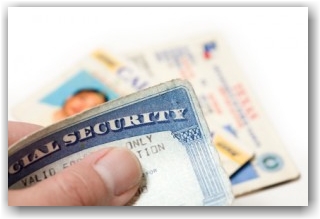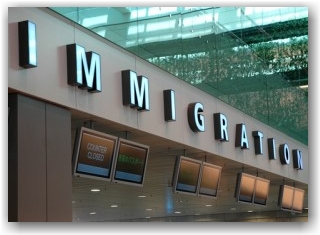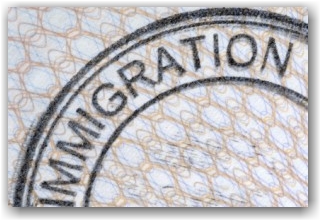Posts Tagged ‘Immigration News’
Thursday, March 14th, 2013

A new edition of the I-9 employment eligibility verification form was introduced last week. USCIS has been working on the revised I-9 form for more than a year. The revised M-274 Handbook for Employers can be accessed at the same link. Many areas on the I-9 Central website have also been updated. Note the webinar schedule for the new form.
The new edition of the I-9 Form, dated March 8, 2013, will take effect immediately on publication and will become the only acceptable version of the form. Employers who need to make necessary updates to their business processes to allow for use of the new Form I-9 may continue to use other previously accepted revisions (Rev.02/02/09)N and (Rev. 08/07/09)Y until May 6, 2013. Effective May 7, 2013, all employers must use the revised Form I-9 for each new employee hired in the United States. Employers who are not using the I-9 form following the 60-day grace period will be subject to fines and penalties under 274(a) of The Act (The Immigration and Nationality Act), IRCA, as well as ICE.
The revised Form I-9 has several new features, including new fields and a new format to reduce errors, and more clearly describes the information employees and employers must provide in each section. The instructions to the form are now 7 pages in length, and we recommend that you provide the instructions and the list of documents to your new employees to refer to during the process. The form looks much more official and now displays the DHS seal at the top left of the form with space built in to eventually implement future barcode technology. Helpful new images have been added to the M-274 Handbook to illustrate how employees and employers can complete Sections 1-3 of the new form. Please also see page 23 for updated guidance on recording changes of name and other identity guidance.
In the USCIS Stakeholder conference held on March 11, 2013, many of the questions centered around the following topics that we thought might be helpful to share with you, as follows:
- Do I need to fill out a new I-9 forms for all employees? You do not need to do new I-9 forms for those employees who already have one.
- When to accept receipts: Receipts for initial employment or renewal (during reverification) of employment are not acceptable. There are 3 different documents that qualify as receipts are: (a) Receipts may be presented for sections 2 and 3 if the document was lost, stolen or damaged; the receipt is valid for 90 days. (b) Temporary I-551 (a printable notation on a machine-readable immigrant visa inside a foreign passport). This is a 1-year permanent residency stamp for a foreign national that has received permanent status abroad. The Form I-551 (permanent residency card) must be presented prior to or no later than the expiration stamp inside the passport. (c) An I-94 entry card with an unexpired refugee stamp. This is considered a receipt for an Employment Authorization Document (EAD card), or a combination of an unrestricted Social Security Card and a List B document and is valid for 90 days.
- Rehires and Reverifications: If you are rehiring an employee who completed an I-9 form within 3 years, you can continue to use the existing I-9 form, and record any name changes, the rehire date and other required information in Section 3 and change the date of hire in Section 2 (initial/date). If their work authorization as changed you can make the correction on the existing form if still valid or generate a new form I-9 and fill in Section 3 and attach to the old form. As a reminder, do not reverify US citizens, permanent residents, conditional residents, asylees with unrestricted work authorization and List B identity documents such as driver’s licenses and state ID cards.
- The use of notaries: Notaries are “designated agents” of the employer. They should not imprint their notary stamp on any I-9 documentation or attach same to the I-9 form. The employer is responsible for their actions and any violations relating to Form I-9. Photocopies of I-9 forms are also not acceptable from Notaries. A notary or any other designated agent appointed by the employer must examine the original documents presented to them and thoroughly complete and sign section 2 of the form and return the original to the employer, along with photocopies of the presented documents should this be a company policy.
- Recording social security numbers: On the List of Acceptable Documents for List C, Social Security card restrictions are explained to better assist in examination of the document. Note that individuals with temporary work authorization are issued restricted social security cards that indicate: “Not valid without USCIS/DHS work authorization
- Recording the date of hire in Section 2: When an offer of employment is extended and accepted but the employee has not yet started, the I-9 may be completed using that date instead of the ‘actual’ start date of employment. You may then go back into the form and adjust the date to the actual start date (the 1st day of work for pay). Recruiters or recruiters for a fee are not required to enter the employee’s first day of employment. However, you may enter the first day the employee was placed in a job pool after an offer of employment and acceptance.
- Must employee present documents that correspond to box checked in Section 1? No, employers may not insist on viewing any particular documents. However, if information is recorded in section 1 that puts the employer “on notice” that work authorization may be expiring, you are required to track that date and follow-up with the employee concerning their continued work authorization.
USCIS has indicated that a good place to begin implementing the use of the new I-9 form is to take time to first thoroughly read and digest the revised M-274 Handbook for Employers. Download it from the USCIS website and provide a complete copy to each and every employee charged with processing and managing the I-9 function at your place of employment to ensure that they are aware of the changes and are equipped to properly implement them. Update your company policies to reflect the changes in the form.
For those of you who manage your I-9 forms via an electronic software vendor, this is absolutely the right time to have a conversation with them concerning their compliance with the new form and make sure that it complies with all pertinent rules and regulations for I-9 electronic software . This is also an excellent time to think about additional training for your staff. Refer here for our services and solutions.
To order copies of the new I-9 form from USCIS, you can call 1-800-870-3676.
Tags: Changes to new I-9 Form, Department Of Homeland Security (DHS), Department Of Labor (DOL), Employer Sanctions, Employment Eligibility Verification, Handbook for Employers, I-9 AUDIT, I-9 Form Penalties, I-9 Training, I-9/E-Verify News, ICE, Immigration News, Legal Workforce, M-274, New I-9 Form, Social Security, USCIS
Posted in Department Of Homeland Security (DHS), Department Of Labor (DOL), Employer Compliance, I-9/E-Verify News, ICE, Immigration Legislation, Immigration News, Social Security, Staffing Agencies, USCIS | Comments Off on New I-9 Form Update from Immigration Compliance Group
Thursday, March 7th, 2013
 A new edition of the I-9 employment eligibility verification form has been introduced today and has been published in the Federal Register as of this writing. USCIS has been working on the revised I-9 form for more than a year. In March 2012, it published a proposed revision for public comment.
A new edition of the I-9 employment eligibility verification form has been introduced today and has been published in the Federal Register as of this writing. USCIS has been working on the revised I-9 form for more than a year. In March 2012, it published a proposed revision for public comment.
The new edition, dated March 8, 2013, will take effect immediately on publication and will become the only acceptable version of the form. Employers who need to make necessary updates to their business processes to allow for use of the new Form I-9 may continue to use other previously accepted revisions (Rev.02/02/09)N and (Rev. 08/07/09)Y until May 7, 2013. After May 7, 2013, all employers must use the revised Form I-9 for each new employee hired in the United States. Employers who are not using the I-9 form following the 60-day grace period will be subject to fines and penalties under 274(a) of The Act (The Immigration and Nationality Act), IRCA, as well as ICE.
The revised Form I-9 has several new features, including new fields and a new format to reduce errors. The instructions to the form also more clearly describe the information employees and employers must provide in each section. To order copies of the new I-9 form from USCIS, you can call 1-800-870-3676.
For those of you who manage your I-9 forms via an electronic software vendor, this is absolutely the right time to have a conversation with them concerning their compliance with the new form. This is also a good time to think about additional training for your staff. Refer here for our services and solutions. We will be reviewing the form very carefully in the next few days and will post our comments and guidance.
Tags: Employment Eligibility Verification, I-9 Form, I-9/E-Verify News, ICE, Immigration News, Immigration Reform, New I-9 Form, Social Security, USCIS
Posted in I-9/E-Verify News, ICE, Immigration Legislation, Immigration News, Social Security, USCIS | Comments Off on NewsFLASH —— New I-9 Form Released March 8, 2013
Thursday, February 28th, 2013
The SSA Program Policy Information Site contains the public version of the Program Operations Manual (POMS). The POMS is a primary source of information used by Social Security employees to process claims for Social Security Benefits.
Today, SSA issued updates on several topics of interest to our readers and clients concerning I-9, EAD and SSA document examination and interpretation, as follows:
1) EAD’s for NIVs: https://secure.ssa.gov/poms.nsf/lnx/0110211420
2) How to Verify Asylee Status: https://secure.ssa.gov/poms.nsf/lnx/0110211213
3) Evidence of Asylee Status When Form I-94 (Arrival and Departure Record) is Submitted: https://secure.ssa.gov/poms.nsf/lnx/0110211207
4) Evidence of Asylee Status for an SSN Card: https://secure.ssa.gov/poms.nsf/lnx/0110211205
You will find this a wealth of excellent information and a great resource. Should you have any questions or comments, please feel free to contact our office.
Tags: Asylee I-9 Verification, EAD Card, EADs for Nonimmigrants, Employment Authorization, I-9 Document Interpretation, I-9 Form, I-9/E-Verify News, Immigration News, Social Security Administration POMS, SSA I-9 Guidance; I-9 Document Examination, USCIS
Posted in Employer Compliance, I-9/E-Verify News, ICE, Immigration News, Social Security, USCIS | Comments Off on I-9/E-Verify News: Recent Social Security Administration Guidance and Updates
Wednesday, February 20th, 2013
 This new process allows certain immediate relatives of US citizens who are physically present in the USA and are seeking permanent residence, to apply for and receive provisional unlawful presence waivers BEFORE departing the US for consular processing of their immigrant visa applications abroad.
This new process allows certain immediate relatives of US citizens who are physically present in the USA and are seeking permanent residence, to apply for and receive provisional unlawful presence waivers BEFORE departing the US for consular processing of their immigrant visa applications abroad.
The benefit of this is that it will reduce the time that U.S. citizens are separated from their immediate relatives while those family members go through the consular process overseas to obtain an immigrant visa. Immediate relatives of U.S. citizens who would need a waiver of unlawful presence in order to obtain an immigrant visa could file a new Form I-601A, Application for Provisional Unlawful Presence Waiver, before leaving the United States to obtain an immigrant visa at a U.S. Embassy or Consulate abroad. All individuals eligible for this streamlined process are still required to depart the United States and must meet all legal requirements for issuance of an immigrant visa and admission to the United States.
An individual may seek a provisional unlawful presence waiver if he or she:
- Is physically present in the United States;
- Is at least 17 years of age;
- Is the beneficiary of an approved immigrant visa petition (I-130) classifying him or her as an immediate relative of a U.S. citizen;
- Is actively pursuing the immigrant visa process and has already paid the Department of State immigrant visa processing fee;
- Is not subject to any other grounds of inadmissibility other than unlawful presence; and
- Can demonstrate that the refusal of admission would result in extreme hardship to a U.S. citizen spouse or parent.
An immediate relative would not be eligible for the proposed process if he or she:
- Has an application already pending with USCIS for adjustment of status to lawful permanent resident;
- Is subject to a final order of removal or reinstatement of a prior removal order;
- May be found inadmissible at the time of the consular interview for reasons other than unlawful presence; or
- Has already been scheduled for an immigrant visa interview at a U.S. Embassy or Consulate abroad.
Allowing immediate relatives of U.S. citizens to receive provisional waivers in the United States before departure for their immigrant visa interview at a U.S. Embassy or Consulate means that:
- Immigrant visa processing times will improve because of greater capacity in the United States and fewer case transfers between USCIS and the Department of State;
- Immigrant visas will be issued without unnecessary delay (if the individual is otherwise eligible); and
- The period of separation and hardship many U.S. citizens would face due to prolonged separation from their family members will be minimized.
For additional information,we link to the I-601A Questions and Answers document.
Should you wish to become a client of our office, please contact us.
Tags: Consular Processing, DOS, Green-Cards, I-601A Provisional Waiver Application, Immediate Relatives of US Citizens, Immigrant Visas (I-140 Petitions), Immigration News, Immigration Reform, PERMANENT RESIDENCY, Provisional Unlawful Presence Waiver, Unlawful Presence Waivers, US Consulates, US Work Authorization
Posted in Comprehensive Immigration Reform, Department of State, Immigrant Visas (I-140 Petitions), Immigration Legislation, Immigration News, US Consulates | Comments Off on Provisional Unlawful Presence Waiver Process goes ‘live’ March 4, 2013
Monday, January 28th, 2013

A group of 8 bipartisan senators have reached a deal on the outline of a comprehensive immigration overhaul, a development that is long overdue and will assist in framing the forthcoming immigration debate in Congress. Senator Schumer has stated that it is their plan that this can be turned into legislation by March and put into law by mid-late summer 2013.
According to a five-page document released today, the proposal provides a broad-based approach, agreed to in principle by eight senators, that seeks to overhaul the immigration system and create a pathway to citizenship for the nation’s roughly 11 million illegal immigrants.
Although all that we have focused on for years now is nothing else but border and enforcement issues and employment verification, the proposal takes enforcement to the next level by perfecting an entry/exit tracking system, and greater usage of E-Verify or a new and improved E-Verify system that is referred to as “fast and reliable.”
Legislators will create a commission comprised of border governors, attorneys general and community leaders living along the southwest border to monitor the progress of securing the border and to make a recommendation regarding when the bill’s security measures outlined in the legislation are completed.
While security measures are put in place, those who came and remained in the USA without permission, will be required to register with the government. This will include background checks, paying a fine and back taxes to earn probationary legal status to continue to live and work legally in the USA.
Once enforcement measures have been completed, those in probationary legal status will be required to go to the back of the line to wait their turn, pass an additional background check, pay taxes, learn English and civics and demonstrate a history of work in the US and current employment, among other requirements, to earn the opportunity to apply for lawful permanent residency (green-card) status. Those who successfully complete these requirements can eventually earn a green-card (legal permanent residence).
Special provisions will be accorded to the Dreamers (minor children who did not knowingly choose to violate any immigration laws) who will have different requirements that will include a pathway to citizenship.. Individuals who have been working illegally in the agricultural industry performing difficult work for low wages to ensure the safety of the food supply of the US will also be provided special requirements and will have a pathway to citizenship.
Those who graduate from an American University with a Ph.D or Master’s Degree in science, technology, engineering or math (STEM), will be awarded permanent residency (green-card status) to keep the best and brightest talent in the USA.
There are also provisions for a guest worker program referred to as “lower-skilled workers” in the proposal that will meet the needs of employers, the agricultural industry, including dairy, to find agricultural workers and lower skilled immigrants when the economy is creating jobs and fewer when the economy is not creating jobs. If this is the H-2B program, we sincerely hope that it gets an overhaul – it’s entirely too complicated, takes too long and completely discourages employers by overburdening them with excessive details.
Resources
Please see the senator’s attached Transcript. It’s certainly a an introduction to a long-awaited immigration conversation that is achievable – but difficult. A link to a transcript from the President’s speech in NV; and the President’s Immigration Fact Sheet.
What are the differences between the Senate and Obama Plan?
Tags: Agricultural Workers, Border Patrol, border security, Comprehensive Immigration Reform, E-Verify, Employment Eligibility Verification, Entry/Exit System, Guest Worker Program, IMMIGRATION ENFORCEMENT, Immigration News, Immigration Reform, Legal Workforce, Obama NV speech, STEM Students, Unskilled Workers, WORKPLACE ENFORCEMENT
Posted in Agriculture, Comprehensive Immigration Reform, Congress, Immigration Legislation, Immigration News | Comments Off on Senators Pitch Immigration Compromise
Monday, January 7th, 2013

USCIS today began the online transition, that replaces the existing Adjudicator Field Manual (AFM) and the current USCIS Memoranda website, by releasing the first volume of the new USCIS Policy Manual on Citizenship and Naturalization. Today’s release follows an unprecedented, agency-wide review of USCIS policies that incorporates feedback from thousands of agency employees, customers and stakeholders. The complete USCIS Policy Manual will comprise several volumes, each pertaining to the different areas of immigration benefits. This initial release begins the process of providing a single online reference for USCIS policies.
The manual provides a search mechanism, links to federal regulations, updates, memoranda and immigration forms. The Citizenship and Naturalization volume will become effective as of January 22, 2013. USCIS will notify as each volume of the manual is released. This is a very impressive effort and a centralized location that is incredibly user friendly.
Take a look around:
1) Press Release
2) Video Announcement and Preview
3) The Policy Manual
Tags: AFM, Department Of Homeland Security (DHS), Immigration News, USCIS, USCIS Policy Manual
Posted in Department Of Homeland Security (DHS), Immigration News, USCIS | Comments Off on USCIS Releases First Volume of new Online Policy Manual
Sunday, December 30th, 2012

As 2012 winds down, with year-end planning sessions and budget meetings for 2013, how would you rate your company’s employment eligibility compliance program, as it stands right now? We are not in the bubble bursting business, but we’ve yet to see a compliance program that doesn’t need some upgrading and refinement – no one’s is perfect.
According to new data from ICE, since 2007, employer I-9 audits have increased from 250 to more than 3,000 in 2012. From fiscal years 2009 to 2012, the total amount of fines grew to nearly $13 million from $1 million. Statistics released by ICE in July 2012 stated that overall, $87.9 Million in fines have been imposed on employers for violations. The number of company managers arrested has increased to 238. Widespread employer audits will continue to increase this year. Plain and simple, failing to comply with IRCA’s I-9 rules will continue at a rapid rate, resulting in significant fines, loss of access to government contracts, an onslaught of negative publicity, business closure, criminal penalties and imprisonment.
With all the advice, blogs and articles written about the most complicated 1-page form on the planet, there are some basics – a simple formula that, if implemented, followed and maintained, will greatly enhance your level of I-9 compliance and reflect your company’s genuine desire to get its compliance house in order. This is what we recommend:
- Invest in a comprehensive I-9 audit by a knowledgeable attorney or professional who actually practices in this area of the law. Don’t engage in a self-audit without participating in a thorough training program first. This will cause more harm than good; it’s like the blind leading the blind.
- Following the audit and the review of your report of findings, get trained before the correction process begins. Who should be trained? All those who have hands-on exposure to the I-9 process at all of your organization’s locations…and all those who supervise the process and staff. Make training and reading the M-274 Employer Manual absolute requirements for those assigned to I-9 processing and management.
- Establish a written Compliance Policy. This does not need to be a huge undertaking, but should reflect your company policy concerning the steps you’ve taken to assure a compliant workforce and a culture of compliance at your organization. It will be your road map and reflects that you take compliance seriously. ICE will request this document, amongst many others, should they ever come knocking on your door.
- Appoint a Compliance Guru – one who has a senior level of knowledge, who will monitor your internal compliance program, review your I-9 forms every few months for accuracy and completeness, provide updates and arrange for refresher training on a yearly basis.
- Consult with a trusted professional in the field when questions or challenges arise – don’t guess.
Remember, the key to defending any employment related investigation is to evidence that there is and has been a consistent pattern of responsible, good faith effort on the part of the employer in establishing a compliant workforce. Stay informed, subscribe to our Blog, newsletter, and join in the conversation on our LinkedIn Group I-9/E-Verify: Smart Solutions for Employers. Check out our compliance services and solutions here, and make a concerted effort this year to increase your level of compliance by following the above formula.
Tags: Compliance Policy, E-Verify, Employment Eligibility Verification, I-9 AUDIT, I-9 Form, I-9 Immigration Compliance, I-9 Training, I-9/E-Verify News, ICE, ICE Audit, Immigration compliance, Immigration News, Legal Workforce, Mandatory E-Verify, USCIS
Posted in Comprehensive Immigration Reform, Employer Compliance, I-9/E-Verify News, ICE, Immigration Legislation, Immigration News, OSC, USCIS | Comments Off on I-9/E-Verify: 2013 Compliance Considerations for Employers
Monday, September 17th, 2012
 On Sept. 16, 2012, E-Verify provided several enhancements to improve your experience with the program. We particularly like these new features:
On Sept. 16, 2012, E-Verify provided several enhancements to improve your experience with the program. We particularly like these new features:
- For Corporate Administrators: A new Web-based tutorial replaces the live webinar training required of new Corporate Administrators. The tutorial also serves as a resource for existing Corporate Administrators. To access the E-Verify Tutorial for Corporate Administrators, select the ‘Take Tutorial’ link under My Resources in the left-hand navigation menu.
- A new E-Verify User Manual for Corporate Administrators is now available from the ‘View User Manual’ link under My Resources in the left-hand navigation menu.
- They have also come up with a process for HR’s who must record the foreign passport and I-94 arrival-departure card (that can now take up to 45 days to access) in E-Verify
Should you wish to sign up for USCIS’ free E-Verify training, they have several monthly sessions. You can access their training schedule here.
By the way, the program is now compatible with Firefox, Chrome and Safari.
Tags: E-Verify Corporate Administrators, E-Verify Enhancements, E-Verify Training, Employment Verification, I-9 Form, I-9/E-Verify News, Immigration News, Legal Workforce, USCIS
Posted in Employer Compliance, I-9/E-Verify News, ICE, Immigration News, USCIS | Comments Off on E-Verify Releases New Enhancements
Tuesday, September 11th, 2012
By: Timothy Sutton, Communications Editor
 After two years of being deadlocked in the court system, the injunction preventing Arizona’s police force from enforcing the racially controversial “papers please,” program was lifted Wednesday by U.S. District Court Judge Susan Bolton. The decision is the latest legal move in Valle del Sol v. Whiting, a class action legal challenge to SB 1070 that was filed in May 2010. Plaintiffs include an Arizona-born citizen of Spanish and Chinese descent who was racially profiled. “While today’s ruling puts civil rights at risk, it does nothing to undermine our resolve to continue fighting until SB 1070 is struck down in its entirety,” said Chris Newman, legal director of the National Day Laborer Organizing Network. The Supreme Court upheld SB 1070 2(b), also known as the “papers please,” provision, earlier this summer. However, Justice Kennedy suggested there would be clear constitutional problems if the law were used to target racial or ethnic minorities, or to detain people for an unreasonable period of time while checking their immigration status. Opponents assert this unwanted outcome of targeting minorities is certain to transpire.
After two years of being deadlocked in the court system, the injunction preventing Arizona’s police force from enforcing the racially controversial “papers please,” program was lifted Wednesday by U.S. District Court Judge Susan Bolton. The decision is the latest legal move in Valle del Sol v. Whiting, a class action legal challenge to SB 1070 that was filed in May 2010. Plaintiffs include an Arizona-born citizen of Spanish and Chinese descent who was racially profiled. “While today’s ruling puts civil rights at risk, it does nothing to undermine our resolve to continue fighting until SB 1070 is struck down in its entirety,” said Chris Newman, legal director of the National Day Laborer Organizing Network. The Supreme Court upheld SB 1070 2(b), also known as the “papers please,” provision, earlier this summer. However, Justice Kennedy suggested there would be clear constitutional problems if the law were used to target racial or ethnic minorities, or to detain people for an unreasonable period of time while checking their immigration status. Opponents assert this unwanted outcome of targeting minorities is certain to transpire.
However, Governor Jan Brewer insists that the “papers please,” law does not allow Arizona law enforcement to conduct pretext stops because it requires reasonable suspicion. In a public statement she claimed Wednesday’s District Court ruling is “one big step closer to implementing the core provision of SB 1070.” That provision? Ridding Arizona of illegal immigrants.
Arizona’s highly controversial Maricopa County Sheriff Joe Arpaio was also been quoted on the Glenn Beck Show, clarifying his interpretation of reasonable suspicion, “If they have their speech, what they look like, if they look like they come from another country, we can take care of that situation.” As Brewer and Arpaio ramp up for the certain increase in detainment leading to deportation both Cecilia Wong of the ACLU and Victor Viramontes of MALDEF have committed to continue the fight against SB 1070.
It won’t be long before SB 1070 2(b) is back in the courthouse being challenged for racial profiling and discrimination based upon national origin. We will keep you updated on those and other immigration related breaking news as it develops. For more information, contact one of our immigration professionals at info@immigrationcompliancegroup.com or call 562 612.3996.
Tags: ACLU, Arizona Show me your Papers, Comprehensive Immigration Reform, Governor Jan Brewer, illegal immigrants, Immigration News, Immigration Reform, MALDEF, Papers Please, Racial Profiling, SB 1070, SHERIFF JOE ARPAIO, Undocumented Workers
Posted in Comprehensive Immigration Reform, Congress, DACA | DAPA, Immigration Legislation, Immigration News | Comments Off on Politics As Usual: Show Me Your Papers Survives AZ Court
Friday, September 7th, 2012
The Department of Homeland Security issued an update today that the Department of Homeland Security (DHS) is working to resolve this issue and will have a fix on September 14, 2012.
:::::::::::::::::::::::::::::
Without any advance notice, the CBP has made changes that affect the I-9 form by no longer issuing paper I-94 cards and no longer stamping I-20 forms for F and M student visas, or form DS-2019 Certificate of Eligibility for Exchange Visitors and Foreign Students, affecting both J and F visa holders.
Customs and Border Protection is in the process of automating traveler arrival records (I-94 cards) to streamline passenger processing. The current processing time for entering foreign visitors’ travel information into the I-94 database is 30 days or more. This does not affect the majority of foreign travelers visiting for business or leisure and will not affect any visitor’s record of departure. But it will greatly influence how you document Section 2 of the I-9 form for the nonimmigrant employee that produces a List A foreign passport with an I-94 entry card.
PLEASE NOTE: With the newly proposed 2-page I-9 form, no guidance has as yet been provided regarding the I-94 card as an acceptable List A document in concert with a foreign passport. We will keep you posted concerning these changes as soon as we receive new guidance. In the meantime, we recommend that you print out this information and attach it to any new employee’s I-9 form who would normally produce an I-94 record (but doesn’t have one and is waiting to access an electronic version) along with a foreign passport as a List A document.
CBP has suggested the following: Nomiggrants may need to prove their legal-visitor status within the first 30-45 days of their U.S. stay to:
Employers;
Motor vehicle registration or drivers’ licensing agencies;
The Social Security Administration;
U.S. Citizenship and Immigration Services; or
Universities and schools.
If during this timeframe, visitors need to provide evidence of legal status they should include the following:
Unexpired foreign passport; and
Country of Citizenship
CBP Arrival/Departure Record, Form I-94 (if issued)
Contact CBP for more information or with questions.
Tel: (877) CBP-5511
TTD: (866) 880-6582
If a state benefit granting agency rejects an unstamped Form I-20/DS-2019, applicants may make an appointment with USCIS online through InfoPass and take their Form I-20/DS-2019 to their local USCIS office to be stamped. ( InfoPass ) This transitional step will end on Nov. 21, 2012.
International students and scholars who encounter issues with their state or federal benefit applications should continue to contact the Immigration and Customs Enforcement Student and Exchange Visitor Program (SEVP) at (703) 603-3400 or SEVP@dhs.gov.
Please feel free to contact our office should you have questions concerning these changes, 562 612.3996 or email info@immigrationcompliancegroup.com
Tags: CBP, DS-2019 form, Electronic I-94 card, F Visa, I-9 Form, I-9/E-Verify News, I-94 Card, ICE, Immigration News, J Visa, Legal Workforce, M Visa, New I-9 Form, Student Visas, USCIS
Posted in Customs & Border Protection(CBP), Employer Compliance, I-9/E-Verify News, ICE, Immigration Legislation, Immigration News, USCIS | Comments Off on Update: CBP Makes Changes Affecting I-9 Form, F, M and J Visa Stamping








